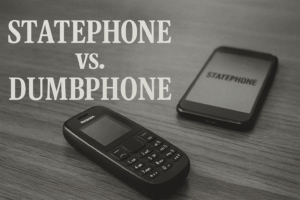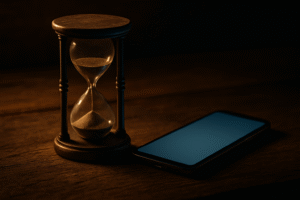
We’ve reached a strange moment in the so-called Digital Age. The very tool once marketed as liberating — the smartphone — is now often demanded by the state itself. From banking to identity checks, tickets to tax records, the default answer to “how do I access this?” is: “download the app.”
That shift changes the meaning of the device in our pocket. The phone is no longer ours alone. Increasingly, it has become a STATE phone — a digital jail key demanded by authorities, service providers, and companies who assume everyone carries one, all the time.
Why DUMB Is Becoming Popular Again
In the UK and across the West, there’s been a quiet but growing counter-trend: people moving back to dumbphones or minimalist handsets.
The motivations vary, but the themes are clear:
- Escape from distraction: No endless notifications or algorithm-driven feeds.
- Privacy: Less data harvested and fewer apps demanding access to your life.
- Simplicity: A device that lasts days on a single charge, makes calls, and sends texts.
- Symbolism: A small act of resistance against the assumption that your every move must be mediated by a “smart” device.
Gen Z call it “digital detox.” Parents buy them for children to avoid social media addiction. Some of us just want peace of mind — and a phone that is, at its core, still a phone.
Why DUMB Might Not Be Dumb After All
Carrying a DUMB phone doesn’t mean opting out of modern life entirely. It means reframing.
Instead of living through a device, you carry a simple line of communication. Calls. Texts. Maybe a bit of FM radio. No permanent tracking beacon.
Meanwhile, your STATE phone — still needed for government services, banking apps, or the “digital ID” gateways increasingly imposed — can be left at home, charged and waiting. You pull it out only when truly necessary.
This dual-device lifestyle restores balance. One phone for the state. One for yourself.
The Compromises
Of course, this path isn’t free of friction.
- No maps or navigation on demand. The compromise is planning ahead: paper maps, pre-printed routes, or a GPS device if you must.
- No instant music streaming. Instead: a radio, an MP3 player, or the quiet.
- Fewer apps. Some services assume app-only access. You’ll need your STATE phone for those moments.
- Lower-spec camera. The 2MP lens on many dumbphones won’t rival a modern smartphone. But perhaps the trade-off is intentional: live the moment instead of documenting it.
For many, those compromises are not deal-breakers. They’re a feature.
My Choice: Nokia + PAYG Calls & Texts
After weighing it up, I leaned towards Nokia. The brand has long stood for durability and trust — and its feature phone line still carries that ethos.
I chose the Nokia 235 4G:
- Solid build, 4G compatibility for future networks.
- A removable battery, lasting days rather than hours.
- A small camera and Bluetooth for occasional extras, without dragging me back into full “smart” mode.
To go with it, I’ll use a pay-as-you-go SIM focused on calls and texts. No monthly contract, no endless data bundle — just the essentials. That makes the device what it should be: a phone.
The STATE phone stays at home. The Nokia goes in my pocket.
Closing Thought
Maybe the smartest thing you can do in 2025 is buy the dumbest phone.
In a time when governments and corporations alike want your smartphone to be your ID card, your wallet, your gatekeeper to basic services, reclaiming a simple phone is more than nostalgia. It’s a small statement of autonomy.
A reminder that sometimes the best way to stay connected — to yourself and to others — is by disconnecting from the noise.
Hope isn’t what they promise you. It’s how you carry on when they don’t deliver. — Dave Carrera



